About mongooses:
Mongooses are small carnivores in the family of Herpestidae. Prominent examples
are the two sub-species of mongooses (mungo) and meerkats. The mongooses are devided into further subspecies, like the banded mongoose, dwarf mongoose
and yellow mongoose. Apart from diverse subspecies, the mongooses are highly social animals living together in rather
large packs (approx. 15-30 animals) caring for each other.
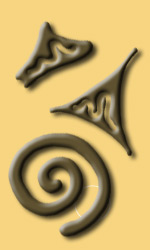 In european zoos, mongooses are popular and visitor's favorites, because of their lovable, curious and agile character:
Almost every zoo is home of meerkats or mongooses or even both sub-species.
In european zoos, mongooses are popular and visitor's favorites, because of their lovable, curious and agile character:
Almost every zoo is home of meerkats or mongooses or even both sub-species.
Mongooses in "Brehm's Life of Animals"
Already in the 19th Century, german zoologist Alfred Brehm describes the mongoose in his well known encyclopedia "Brehm's Animal Life"
(Brehms Thierleben):
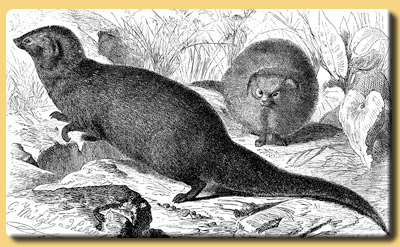 "The mongooses (Herpestea) are characterized [...] by the following features:
Their lower legs rest on a straight and cylindrical body, the head is small or of medium size,
the snout pointed, the eyes rather small, the star eyes circular or oval,
the ears short and rounded, the nose short, naked, lower part flat, grooved in the middle; the feet are five-toed;
cone-shaped tail, rough fur and long haired.
"The mongooses (Herpestea) are characterized [...] by the following features:
Their lower legs rest on a straight and cylindrical body, the head is small or of medium size,
the snout pointed, the eyes rather small, the star eyes circular or oval,
the ears short and rounded, the nose short, naked, lower part flat, grooved in the middle; the feet are five-toed;
cone-shaped tail, rough fur and long haired.
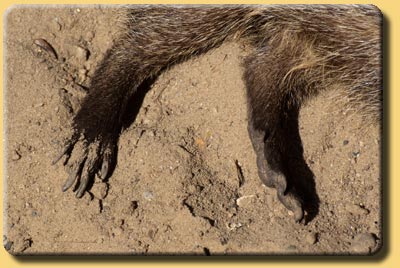 Forty mostly large, strong teeth with well-developed side cusps form the dentition. "
Forty mostly large, strong teeth with well-developed side cusps form the dentition. "
And in particular about the banded mongoose Brehm reports:
"The basic color of the abundant fur of the banded mongoose appears pale gray; although a closer look reveals
several stripes of brown, black and white hairs running across the body-line. On the head and upper neck the hairs end alternately in
black, brown and white tips. On the upper body the hairs end alternately in dark and pale tips. This forms nine to
fifteen regular pairs of transverse bands. The snout and the bottom are rust-colored, the tip of the tail is black."
Natural habitat:
The original home of the mongooses (banded, dwarf and yellow mongoose) is located in eastern and southern Africa
(light green marks on the map), where they prefer the dry scrub and grass savannah.

Some populationas are spotted along the Nile, in the vicintiy of the Nile delta and the coastal regions of the Red
Sea and the Mediterranean.
In general, mongooses avoid pure sand deserts like the Sahara or Namib. Few of the african mongoose-species prefer
the tropical rain-forests and wet-lands.
In ancient times, mongooses (Ichneumons) were introduced in southern Portugal, southern Spain and southern Italy,
where they found a new habitat.
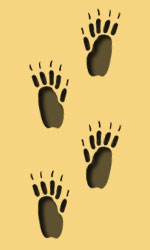

Other species of mongoose (Indian mongoose, small mongoose) live in the tree and shrub steppes of southern Asia
(marked in light brown). Contrary to their African relatives, they also feel comfortable in the rain forests of
southeast Asia as far as Sumatra and Java (Indonesia) and up to a height of about 2000 meters above sea level.
During the 19th Century mongooses were introduced to northern parts of South-America, various islands of the Carribean
and the Pacific for to fight snakes and rats. This caused major problems, as the mongooses not only fought snakes and
rats as intended, but also birds which were not used to carnivores.
Everyday life:
Everyday life of mongooses in the wild consists in the first place in exploring and foraging. As soon as the warm morning
sun sends her rays to the grounds, the mongooses leave their safe den and enjoy the morning sun.
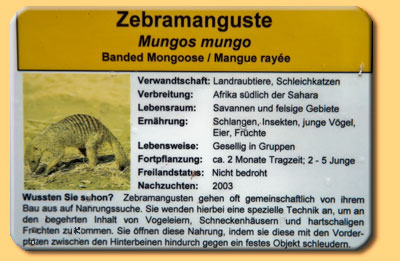
Those who warmed-up start scratching and looking for food in the vicinity and beyond. During their search, communication
between the family members never ceases, as a constant mumbling, cooing and vibrating keeps the family informed and
together. Those sounds of communication transfers expressions of mood, information about positions as well as messages
about great finds!
This is handy if a major food source is discovered, all the family members should benefit. And then, security alerts
are very quick transfered within the family!
Now and then the family has to move. For this purpose, the family maintains a network of dens within the own territory.
On the one hand, it is always interesting to be in a different environment once in a while. On the other hand,
the base of prey has recovered since the last visit, and food is sufficient at the new place. And then animals with evil
intentions (like other mongooses who want to annex the territory) are surprised when the den-owners are gone and defense
their territory from unusual directions...
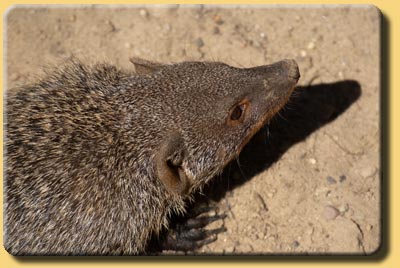
In the african heat of the day, all the animals of the savannah keeps it low and back out to a nice siesta - so
do the mongooses. They lay down in the shadow of some bushes or rocks and rest from their arduous scratching and looking for
food, sleep or give themselves to grooming or training the offsprings.
It is not until late afternoon, when they get busy again, continuing their search for food.

Night comes quickly in Africa and the savannah is pitch black pretty soon once the sun sets. As diurnal animals,
the mongoose retreat into the security of the den - there is too much danger out there in the dark and it's getting
quite cold, too!
Food:
Mongooses are small carnivores. They like to eat meat and enjoy hearty meat-feasts! But abundant food is rare in
the dry savannahs. The mongooses scratch through the sand and light gravel, looking unter debris und branches for spiders,
scorpions, beetles and other insects. Mice, lizards and frogs are not scorned.
Mongooses are hard-working food searchers who do not feel discouraged, if access to a treat is complex: They even
raise and remove large stones and branches in cooperation with family members. The mongooses are very clever: If
they find snails, the snail is rubbed with the paws in the dry sand for to get rid off the slime.
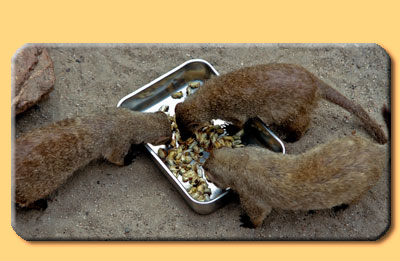
In zoos, mongooses often get day-old chicks and mussels (!) so they are kept busy - it is quite interesting to watch
them cracking the shells and get the meat.
If the zookeeper is in a particular good mood (and the keepers always really love their animals!) he feeds
living locusts - this is a great joy for the mongooses! They swiftly catch the locusts in high enthusiasm,
crack the carapace with their strong teeth and eat with relish. Living mealworms are another popular delicacy!

Sometimes there is a bird's egg in the savannah, which elates the mongooses to a certain extent!
With a special technique they feverishly try to crack the egg: First step is to search a medium-size rock. Then
they stand up on the hind legs with the back against the rock, throw the egg vigorously with the front paws
between the hind legs against the rock. With some skill, this breaks the hard shell and the goo gushing out the shell
is lapped up hungrily.
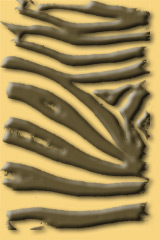
As soon as the vicinity is 'harvested' and food is low, the family has to move on through the territory. For this
purpose, various dens are maintained, which can be reached easily during the hike. The dens are often old termite mounds,
but also small caves, chambers and former dens of other animals such as squirrels, witch were ejected.
Social Community:
Most species of the african mongooses are very social animals: They live in groups with a strict hierarchy
with up to 30 animals, enjoy protection in the community and do not feel comfortable outside their own pack.
Maverick mongooses often suffer from psychological stress - sometimes they even die!
So, there is the motto for the mongooses "One for all and all for one!"
The Asian mongooses often live as couples, but the 'lone wolf' is also very common - the animal world in Asia is not
quite as hostile as the african fauna. In Africa protection ist only secured in a large group.
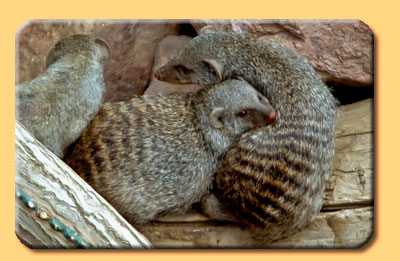
Leader of the family ist always the oldest (dominant) couple, the alpha male und his female. Only the 'alphas' are
permitted to mate. Intimate contacts between family members will not be tolerated. This is a necessity in nature as this
prevents the gen-pool of the family from inbreeding, but leads to problems in case a none-alpha-female gets pregnant.
In some of the mongoose-packs non-alpha-mating results in draconian measures, even in the killing of the new-born or
the exclusion of the perpetrator.
In the group, each member has its own individual task: The alpha male and his female keep the pack together
and provide reproduction to enlarge the family.
To a limited degree, the 'royals' care for the new-borns and young animals. But no later than when the kids are well
on their feet, education is delegated to the 'godfathers'. The adolescent are being tought in everyday-tasks like foraging
and how to identify danger.
This is sometimes a very demanding job, especially since the godfather wants to feed itself but the godchild is still
hungry and scratchs the sand without any success.
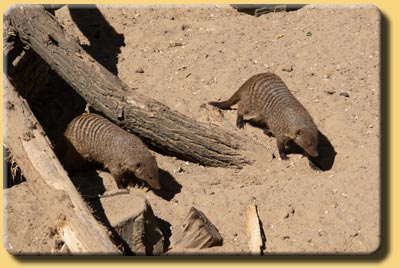
Duties are never strictly distributed for the young animals: Each youngster 'may' have a try in different tasks -
after some time, each animal recognizes it's individual skills and strenghts and recommends as a 'specialist' for
the favorite task. Then this duty is taken very seriously.
For example, the most important task for the guards is to keep on the lookout and watch out for enemies and stay alerted: The
enemy could easily appear as a bird of prey descending nimbly from the skies.

Or the enemy could sneak up gently and almost silent as a snake out of a bush.
Adjacent packs of mongooses are no friends neither. They want to take over the den or even the territory.
All these threats the guard have to keep in mind. For a better view, he often climbs up to a higher position like a tree
stump, a rock or a bush. As soons as danger is near, the guard alarms the pack immediately by loud cries. At once, the
whole pack rushes into the nearby den if the danger is a bird of prey.
If danger appears as a snake or even worse another pack of mongooses, the family is ready to fight: The warriors form
a bustling and compact unit and appoach against the enemy for fighting fiercely and courageously. Mongooses stand
firm and defend their kin to the extreme!
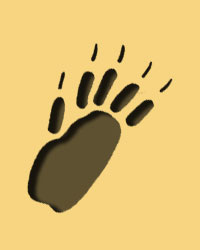

 In european zoos, mongooses are popular and visitor's favorites, because of their lovable, curious and agile character:
Almost every zoo is home of meerkats or mongooses or even both sub-species.
In european zoos, mongooses are popular and visitor's favorites, because of their lovable, curious and agile character:
Almost every zoo is home of meerkats or mongooses or even both sub-species.
 "The mongooses (Herpestea) are characterized [...] by the following features:
Their lower legs rest on a straight and cylindrical body, the head is small or of medium size,
the snout pointed, the eyes rather small, the star eyes circular or oval,
the ears short and rounded, the nose short, naked, lower part flat, grooved in the middle; the feet are five-toed;
cone-shaped tail, rough fur and long haired.
"The mongooses (Herpestea) are characterized [...] by the following features:
Their lower legs rest on a straight and cylindrical body, the head is small or of medium size,
the snout pointed, the eyes rather small, the star eyes circular or oval,
the ears short and rounded, the nose short, naked, lower part flat, grooved in the middle; the feet are five-toed;
cone-shaped tail, rough fur and long haired.
 Forty mostly large, strong teeth with well-developed side cusps form the dentition. "
Forty mostly large, strong teeth with well-developed side cusps form the dentition. "


 Other species of mongoose (Indian mongoose, small mongoose) live in the tree and shrub steppes of southern Asia
(marked in light brown). Contrary to their African relatives, they also feel comfortable in the rain forests of
southeast Asia as far as Sumatra and Java (Indonesia) and up to a height of about 2000 meters above sea level.
Other species of mongoose (Indian mongoose, small mongoose) live in the tree and shrub steppes of southern Asia
(marked in light brown). Contrary to their African relatives, they also feel comfortable in the rain forests of
southeast Asia as far as Sumatra and Java (Indonesia) and up to a height of about 2000 meters above sea level.
 Those who warmed-up start scratching and looking for food in the vicinity and beyond. During their search, communication
between the family members never ceases, as a constant mumbling, cooing and vibrating keeps the family informed and
together. Those sounds of communication transfers expressions of mood, information about positions as well as messages
about great finds!
Those who warmed-up start scratching and looking for food in the vicinity and beyond. During their search, communication
between the family members never ceases, as a constant mumbling, cooing and vibrating keeps the family informed and
together. Those sounds of communication transfers expressions of mood, information about positions as well as messages
about great finds!

 Night comes quickly in Africa and the savannah is pitch black pretty soon once the sun sets. As diurnal animals,
the mongoose retreat into the security of the den - there is too much danger out there in the dark and it's getting
quite cold, too!
Night comes quickly in Africa and the savannah is pitch black pretty soon once the sun sets. As diurnal animals,
the mongoose retreat into the security of the den - there is too much danger out there in the dark and it's getting
quite cold, too!
 In zoos, mongooses often get day-old chicks and mussels (!) so they are kept busy - it is quite interesting to watch
them cracking the shells and get the meat.
In zoos, mongooses often get day-old chicks and mussels (!) so they are kept busy - it is quite interesting to watch
them cracking the shells and get the meat.
 Sometimes there is a bird's egg in the savannah, which elates the mongooses to a certain extent!
With a special technique they feverishly try to crack the egg: First step is to search a medium-size rock. Then
they stand up on the hind legs with the back against the rock, throw the egg vigorously with the front paws
between the hind legs against the rock. With some skill, this breaks the hard shell and the goo gushing out the shell
is lapped up hungrily.
Sometimes there is a bird's egg in the savannah, which elates the mongooses to a certain extent!
With a special technique they feverishly try to crack the egg: First step is to search a medium-size rock. Then
they stand up on the hind legs with the back against the rock, throw the egg vigorously with the front paws
between the hind legs against the rock. With some skill, this breaks the hard shell and the goo gushing out the shell
is lapped up hungrily.
 As soon as the vicinity is 'harvested' and food is low, the family has to move on through the territory. For this
purpose, various dens are maintained, which can be reached easily during the hike. The dens are often old termite mounds,
but also small caves, chambers and former dens of other animals such as squirrels, witch were ejected.
As soon as the vicinity is 'harvested' and food is low, the family has to move on through the territory. For this
purpose, various dens are maintained, which can be reached easily during the hike. The dens are often old termite mounds,
but also small caves, chambers and former dens of other animals such as squirrels, witch were ejected.

 Duties are never strictly distributed for the young animals: Each youngster 'may' have a try in different tasks -
after some time, each animal recognizes it's individual skills and strenghts and recommends as a 'specialist' for
the favorite task. Then this duty is taken very seriously.
Duties are never strictly distributed for the young animals: Each youngster 'may' have a try in different tasks -
after some time, each animal recognizes it's individual skills and strenghts and recommends as a 'specialist' for
the favorite task. Then this duty is taken very seriously.
 Or the enemy could sneak up gently and almost silent as a snake out of a bush.
Or the enemy could sneak up gently and almost silent as a snake out of a bush.